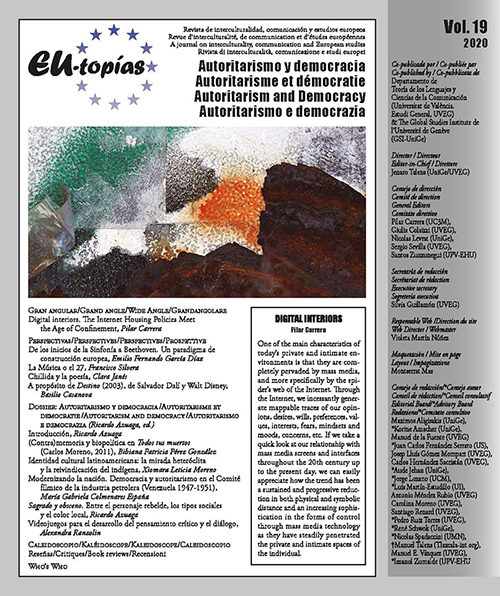Sagrado y obsceno: Between the Character of the Rebel, Social Types and Local Colour
DOI:
https://doi.org/10.7203/eutopias.19.17879Keywords:
Film Analysis, costumbrismo, guerrilla, social types, Venezuelan cinema Abstract
Abstract
From the analysis of the film Sagrado y obsceno (Román Chalbaud, Venezuela, 1975) we distinguish the character of the rebel, to notice some social types introduced in the story, to establish if the presence of local colour by means of stylistic features from costumbrismo contradicts the realistic approach that seems to justify a main part of the prevailing filmic form of the text. In order to reach those objectives we contrast the main character’s features with those of the character of the rebel; outlining the way the rest of the dramatis personae may be represented as far as actual social types or mere replications of collective imaginary stereotypes; finally establishing the way using costumbrismo and local colour reinforces or weakens the conceptual and narrative proposal present in the film.
 Downloads
Downloads
 References
References
Arredondo, Isabel. Motherhood in Mexican Cinema, 1941-1991. The Transformation of Femininity on Screen. North Carolina: McFarland, 2014.
Azuaga, Ricardo. Pandemónium: la filmografía de Román Chalbaud en el cine venezolano. Contexto y análisis. Tesis doctoral. Valencia: Universidad de Valencia, 2016.
Castro de Paz, José Luis. «De miradas y heridas. Hacia la definición de unos Modelos de estilización en el cine español de la posguerra (1939-1950)». Quintana, 12, 2013, pp. 47-64.
Marrosu, Ambretta. «Evolución y significados del personaje rebelde I». Cine al día, 8, 1969, pp. 23-28.
— «Sagrado y obsceno». Cine al día, 21, 1977, pp. 20.
Martínez i Surinyac, Gabriel. El guión del guionista. El desarrollo del guión desde la idea hasta el guión literario. Barcelona: Cims 97, 1998.
Paranaguá, Paulo Antonio. «Román Chalbaud: The «National» Melodrama on an Air of Bolero». Framing Latin American Cinema. Contemporary Critical Perspectives. Ed. Ann Marie Stock. Minnesota: Minnesota University Press, 1997, pp. 162-173.
Pimentel, Luz Aurora. El relato en perspectiva. Estudio de teoría narrativa. México: Siglo XXI, 1998.
Thompson, Kristin. Breaking the Glass Armor. Neoformalist Film Analysis. Princeton: Princeton University Press, 1988.
Ubersfeld, Anne. Semiótica teatral. Madrid: Cátedra, 1993.
Downloads
Published
How to Cite
-
Abstract591
-
PDF (Español)233
Issue
Section
License
![]()
The authors conserve the copyright. All content published in EU-topías. Journal of interculturality, Communication, and European Studies are subject to the license Creative Commons Attribution-NonCommercial-ShareAlike 4.0 license. The full text of the license can be found at <http://creativecommons.org/licenses/by-nc-sa/4.0>
They may be copied, used, disseminated, transmitted and publicly displayed, provided that:
- The authorship and original source of the publication is cited (journal, publisher and URL of the work).
- They are not used for commercial purposes.
- The existence and specifications of this license of use are mentioned.
It is the responsibility of the authors to obtain the necessary permissions for images that are subject to copyright.



